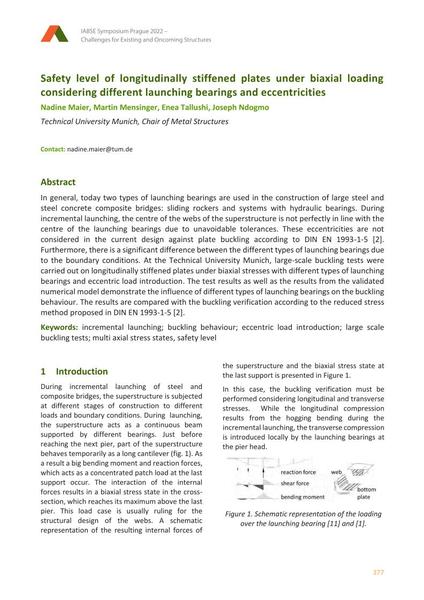Safety level of longitudinally stiffened plates under biaxial loading considering different launching bearings and eccentricities

|
|
|||||||||||
Bibliografische Angaben
| Autor(en): |
Nadine Maier
(Technical University Munich, Chair of Metal Structures)
Martin Mensinger (Technical University Munich, Chair of Metal Structures) Enea Tallushi (Technical University Munich, Chair of Metal Structures) Joseph Ndogmo (Technical University Munich, Chair of Metal Structures) |
||||
|---|---|---|---|---|---|
| Medium: | Tagungsbeitrag | ||||
| Sprache(n): | Englisch | ||||
| Tagung: | IABSE Symposium: Challenges for Existing and Oncoming Structures, Prague, Czech Republic, 25-27 May 2022 | ||||
| Veröffentlicht in: | IABSE Symposium Prague 2022 | ||||
|
|||||
| Seite(n): | 377-386 | ||||
| Anzahl der Seiten (im PDF): | 10 | ||||
| DOI: | 10.2749/prague.2022.0377 | ||||
| Abstrakt: |
In general, today two types of launching bearings are used in the construction of large steel and steel concrete composite bridges: sliding rockers and systems with hydraulic bearings. During incremental launching, the centre of the webs of the superstructure is not perfectly in line with the centre of the launching bearings due to unavoidable tolerances. These eccentricities are not considered in the current design against plate buckling according to DIN EN 1993-1-5 [2]. Furthermore, there is a significant difference between the different types of launching bearings due to the boundary conditions. At the Technical University Munich, large-scale buckling tests were carried out on longitudinally stiffened plates under biaxial stresses with different types of launching bearings and eccentric load introduction. The test results as well as the results from the validated numerical model demonstrate the influence of different types of launching bearings on the buckling behaviour. The results are compared with the buckling verification according to the reduced stress method proposed in DIN EN 1993-1-5 [2]. |
||||
| Stichwörter: |
Taktschiebeverfahren Sicherheitsniveau
|
||||
| Copyright: | © 2022 International Association for Bridge and Structural Engineering (IABSE) | ||||
| Lizenz: | Die Urheberrechte (Copyright) für dieses Werk sind rechtlich geschützt. Es darf nicht ohne die Zustimmung des Autors/der Autorin oder Rechteinhabers/-in weiter benutzt werden. |
||||
